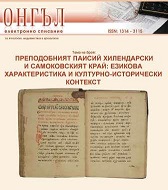Късноримска plumbata от обект „Цари Мали град” при с. Белчин, общ. Самоков (Предварително съобщение)
A late roman “plumbata” from “Tzary Maly Grad” near Belchin village, Samokov region (preliminary notes)
Author(s): Michail HristovSubject(s): Anthropology
Published by: Асоциация за антропология, етнология и фолклористика ОНГЬЛ
Summary/Abstract: The evolving of roman army and warfare in the period of the Dominate is also connected with evolution of the armament. The military theorists from the Late Roman period describe in details many different military tactics and weapons, some of them well known by previous centuries, but others quite new. One of these new weapons is a kind of heavy arrows. They called these arrows plumbata or mattiobarbula. In fact this is an arrow with an ordinary edge and with added lead weight on a wooden shaft, which was shot not by a bow, but with hand. The infantry, light and heavy alike, commonly used this type of weapon and according to the sources, the application of plumbati had a devastating result and caused heavy damage to the enemy. Several finds of these arrows are known from the eastern and western parts of the Empire, and the main part of them comes from Roman frontier fortresses. This is not a surprise, because many regular roman troops were concentrated in the so-called ‘limes’. The article announces a find of an arrowhead of this type far away from the “limes”, in the inner province of Dacia Mediterranea, in a fortified center near the contemporary village of Belchin, in “Tzary Maly Grad” area. There is no surviving data, concerning any lodging of regular roman troops in proximity, so the fact of its presence is curios and very interesting. The shape and other characteristics of the found plumbata makes possible to set its date in the first decades of the fifth century A D. The find is possibly connected with a struggle of the Roman Empire and the Huns in this part of the Balkan Peninsula.
Journal: Електронно списание »Онгъл«
- Issue Year: 2013
- Issue No: 5
- Page Range: 121-129
- Page Count: 9
- Language: Bulgarian

